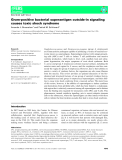


Toxic shock syndrome
-
Staphylococcus aureusand Streptococcus pyogenes(group A streptococci) are Gram-positive pathogens capable of producing a variety of bacterial exo-toxins known as superantigens. Superantigens interact with antigen-present-ing cells (APCs) and T cells to induce T cell proliferation and massive cytokine production, which leads to fever, rash, capillary leak and subse-quent hypotension, the major symptoms of toxic shock syndrome.
 19p
19p  cosis54
cosis54
 04-01-2013
04-01-2013
 38
38
 3
3
 Download
Download
-
Tuyển tập báo cáo các nghiên cứu khoa học quốc tế ngành y học dành cho các bạn tham khảo đề tài: Toxic shock syndrome responsive to steroids...
 3p
3p  thulanh27
thulanh27
 14-12-2011
14-12-2011
 39
39
 3
3
 Download
Download
CHỦ ĐỀ BẠN MUỐN TÌM













